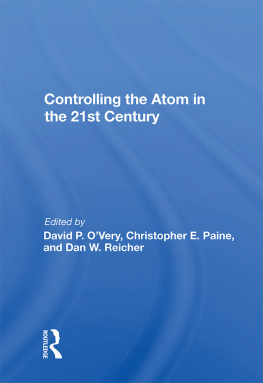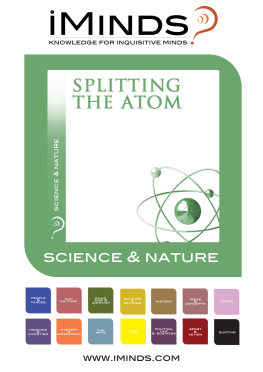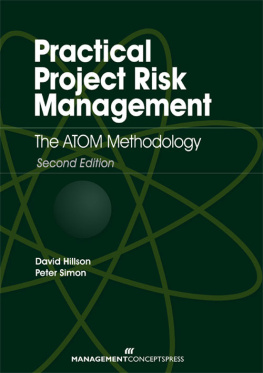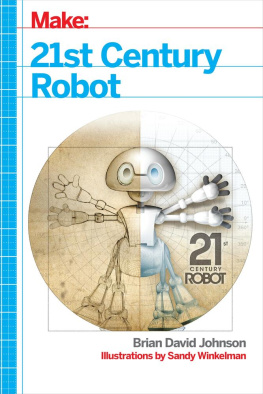Controlling the Atom in the 21st Century
A Natural Resources Defense Council Book
Controlling the Atom in the 21st Century
Edited By
David P. OVery ,
Christopher E. Paine ,
and Dan W. Reicher
First published 1994 by Westview Press, Inc.
Published 2018 by Routledge
52 Vanderbilt Avenue, New York, NY 10017
2 Park Square, Milton Park, Abingdon, Oxon OX14 4RN
Routledge is an imprint of the Taylor & Francis Group, an informa business
Copyright 1994 Taylor & Francis
All rights reserved. No part of this book may be reprinted or reproduced or utilised in any form or by any electronic, mechanical, or other means, now known or hereafter invented, including photocopying and recording, or in any information storage or retrieval system, without permission in writing from the publishers.
Notice:
Product or corporate names may be trademarks or registered trademarks, and are used only for identification and explanation without intent to infringe.
Library of Congress Cataloging-in-Publication Data
Controlling the atom in the 21st century / edited by David P. OVery,
Christopher E. Paine, and Dan W. Reicher.
p. cm.
Includes bibliographical references and index.
ISBN 0-8133-8816-3
1. Nuclear energyLaw and legislation. 2. Nuclear power plants
Licenses. 3. Nuclear nonproliferation. I. OVery, David P.
II. Paine, Christopher E. III. Reicher, Dan W.
K3990.6.C66 1994
333.7924dc20 93-39042
CIP
ISBN 13: 978-0-367-01258-8 (hbk)
Contents
, Christopher E. Paine and Thomas B. Cochran
, Allan Robert Adler
, Kevin T. Knobloch
, Dan M. Berkovitz
, Eric Glitzenstein
, Eric Glitzenstein
, Diane Curran
, Henry R. Myers
, Paul Parshley
, David P. O'Very
, Martin J. Pasqualetti
, Terry R. Lash
The Natural Resources Defense Council (NRDC) is a nonprofit membership organization dedicated to protecting the planet's natural resources and to improving the quality of the human environment. With 170,000 members and a staff of lawyers, scientists, and environmental specialists, NRDC combines the power of law, science, and people in defense of the environment.
For over 20 years, NRDC has been a leader in efforts to: (1) halt commercial use and proliferation of nuclear weapons-usable materials; (2) phase out underground nuclear test explosions; (3) increase public knowledge of, and influence on, both civil and defense nuclear activities; (4) permanently dispose of nuclear waste in an environmentally sound mariner; (5) cooperatively verify storage and dismantlement of U.S. and former Soviet nuclear weapons; and (6) ensure environmental compliance by, and clean-up of, the U.S. nuclear weapons complex. Controlling the Atom in the 21st Century represents NRDC's continued dedication to these and other important nuclear issues.
In December 1992, NRDC assembled a diverse group of professionals at the Graves Mountain Lodge in Syria, Virginia, for a three-day conference to examine solutions to the various problems posed by the civilian and defense uses of nuclear energy. NRDC commissioned a number of working papers that served as the basis for discussion at the conference. These papers were later revised for publication. The papers represent the views of the authors and do not necessarily reflect those of NRDC, the conference participants, or the editors.
David P. O'Very
Christopher E. Paine
Dan W. Reicher
Controlling the Atom in the 21st Century is the product of a diverse group of authors concerned with improving the ways in which the U.S. regulates both civil and defense nuclear activities and controls the dissemination of weapons-usable nuclear materials, technology, and information.
The editors would like to thank the conference participants for their comments on the papers that formed the basis for this publication and acknowledge the support of NRDC's nuclear program staff in Washington, D.C., with special thanks to program assistant Jean Reynolds, Scoville intern Karen Cramer, and visiting associate Eric Fersht for their able assistance during the various stages of this project.
We also want to express our appreciation for the generous support of the John D. and Catherine T. MacArthur Foundation and the Prospect Hill Foundation, which made the Graves Mountain conference and this publication possible. In addition, we gratefully acknowledge the grants provided by the W. Alton Jones Foundation, the Carnegie Corporation of New York, the Ford Foundation, the HKH Foundation, the Rockefeller Brothers Fund, and two anonymous donors in support of NRDC's overall Nuclear Program.
Finally, we thank the 170,000 members of NRDC, whose support makes all our work possible.
D.P.O.
C.E.P.
D.W.R.
Five decades after splitting the atom, both defense and civilian applications of nuclear energy have reached a critical juncture. The demise of the Warsaw Pact and the disintegration of the Soviet Union have removed the longstanding rationale for maintaining a large nuclear arsenal. But the nuclear threat from the former Soviet Union has been replaced by a host of proliferation problems, exemplified by the disclosure of Iraq's clandestine nuclear weapons program and the splintering of the world's largest nuclear superpower, the USSR, into separate states. In addition, the U.S. and Russia are faced with the staggering environmental legacy of nearly fifty years of nuclear weapons production.
On the civilian side, nuclear power utilities have canceled or indefinitely deferred plans to construct more than 100 nuclear power plants since the early 1970s, and no new commercial U.S. reactors have been ordered since 1978. The future of the nuclear power industry is obscured by limited on-site waste storage capacity at some nuclear power plants, the absence of a permanent high-level radioactive waste repository, and the controversy over the siting of low-level waste facilities. At the same time, many utilities are developing alternative means for meeting energy needs, including increased energy efficiency and conservation.
Despite these problems and changes, both defense and civilian nuclear interests continue to plan for future operations. The Department of Energy (DOE) is evaluating a "reconfiguration" program that will consolidate and modernize its nuclear weapons complex. With rising concerns over global warming, dependence on foreign oil, and the safety of aging current reactors, the commercial nuclear industry is seeking to put on line a new generation of smaller, safer, and more efficient standardized reactors. The industry is also expected to seek relicensing of existing reactors whose 40-year licenses will begin to expire around the turn of the century.
The current conditions in the defense and civilian nuclear industries provide an unprecedented opportunity to re-examine underlying policies and regulatory mechanisms for fissile materials and nuclear power production. The upcoming 40th anniversary of the 1954 Atomic Energy Act, the extension conference of the Nuclear Non-Proliferation Treaty in 1995, a new administration, a new Congress, and a dramatically altered geopolitical landscape create the potential for achieving significant reforms in the way the U.S. controls defense and civilian uses of the atom for decades to come.














